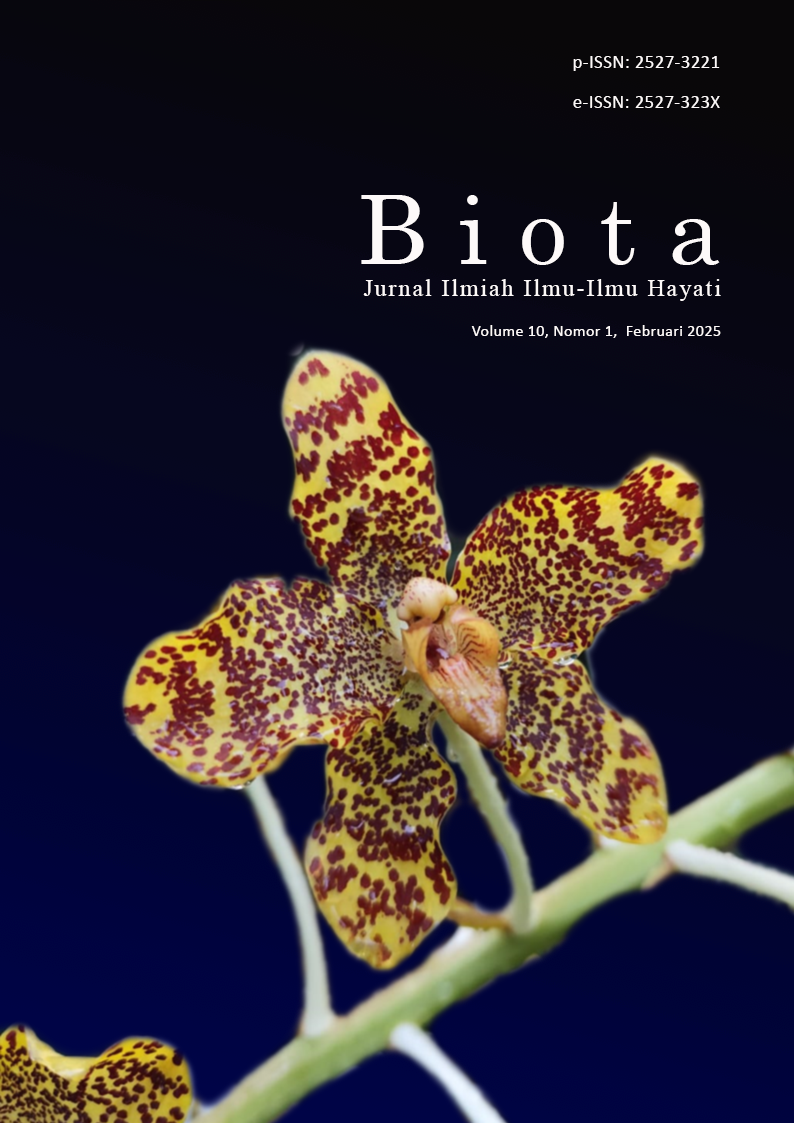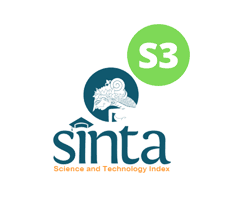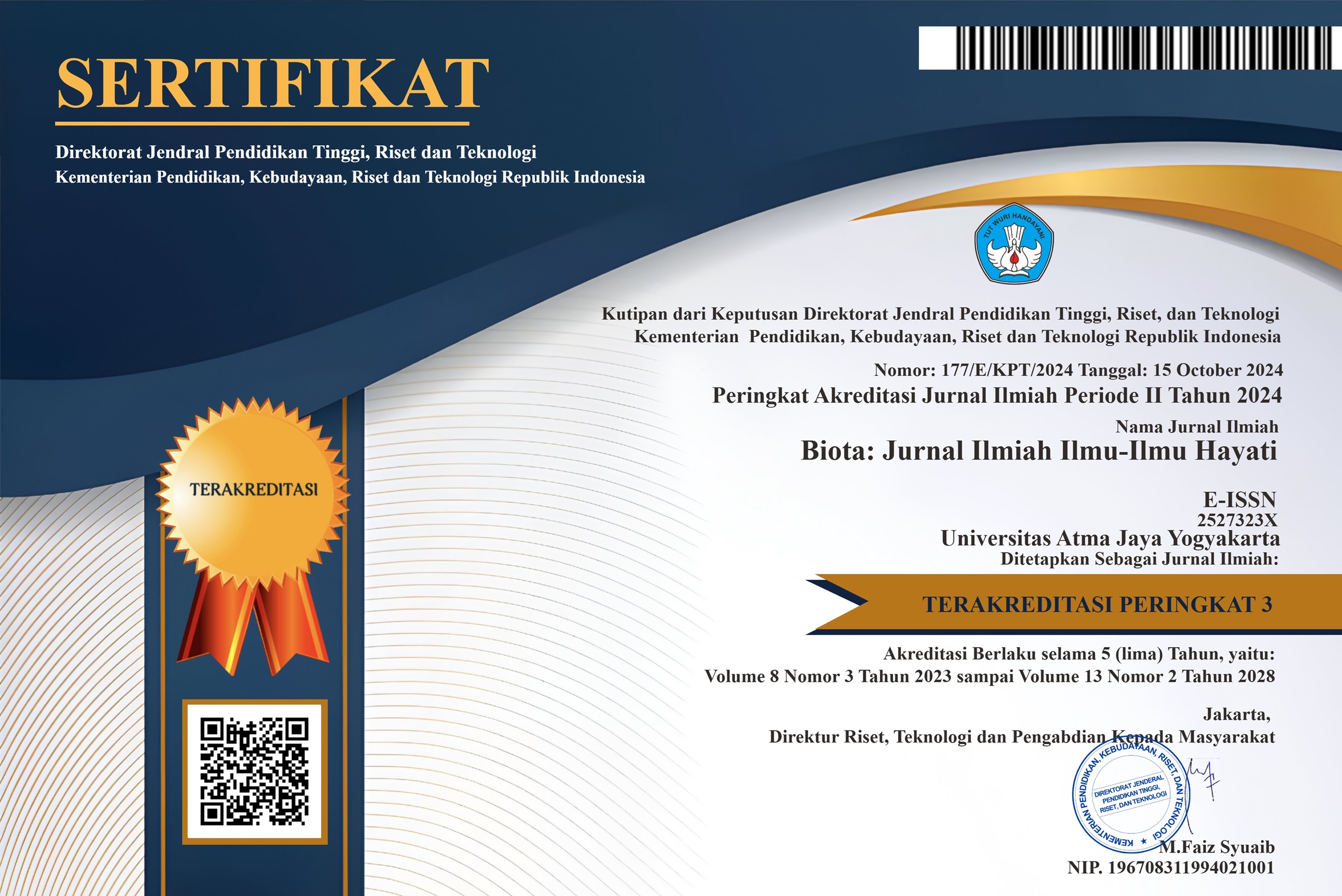The Role of Chloroplast DNA Markers (psbA) in Maintaining the Position of Lemnoideae
DOI:
https://doi.org/10.24002/biota.v10i1.8906Keywords:
Araceae, lemnoideae, molecular taxonomy, phylogenetic, psbAAbstract
The duckweed plant group belongs to the botanical family Araceae and has the potential as a food source. It is difficult to classify and the plants were originally grouped as the Lemnaceae family. However, current molecular taxonomy studies revealed the integration of Lemnaceae into the Araceae family, thus becoming the Lemnoideae subfamily. It is necessary to strengthen the position of Lemnoideae in Araceae using molecular marker psbA from chloroplast DNA This study aimed to determine the role of the psbA chloroplast DNA marker in regulating the position of Lemnoideae. A total of 41 sequences of the psbA gene taken from the species from seven subfamilies in Araceae and one outgroup were collected from the NCBI GenBank and then arranged in FASTA format. Sequence data was then aligned by ClustalX, and phylogenetic trees were reconstructed using PAUP and MEGA. From the resulting phylogenetic trees, it can be conferred that the Lemnoideae subfamily does not form a monophyletic group. Thereby, this in silico study using psbA markers concludes the position ofthe Lemnoideae subfamily in the family Araceae and we recommend not separating the plant group from the family Araceae.
References
Acosta, K., Appenroth, K. J., Borisjuk, L., Edelman, M., Heinig, U., Jansen, M. A., Oyama, T., Pasaribu, B., Schubert, I., Sorrels, S., Sree, K. S., Xu, S., Michael, T. P., & Lam, E. (2021). Return of the Lemnaceae: Duckweed as a Model Plant System in the genomics and postgenomics era. The Plant Cell33(10): 3207–3234.
Al-Dakhil, M., Alghamdi, S., Migdadi, H., Afzal, M., & Ali, A. A. (2021). Morphological characterization and DNA barcoding of duckweed species in Saudi Arabia. Plants 10(11): 2438.
An, D., Zhou, Y., Li, C., Xiao, Q., Wang, T., Zhang, Y., Wu, Y., Li, Y., Chao, D.-Y., Messing, J., & Wang, W. (2019). Plant evolution and environmental adaptation unveiled by long-read whole-genome sequencing of Spirodela. Proceedings of the National Academy of Sciences 116(38): 18893–18899.
Angiosperm Phylogeny Group. (1998). An ordinal classification for the families of flowering plants. Annals of the Missouri Botanical Garden85(4):531-553.
Bog, M., Appenroth, K. J., & Sree, K. S. (2019). Duckweed (Lemnaceae): Its molecular taxonomy. Frontiers in Sustainable Food Systems3: 117.
Bog, M., Appenroth, K. J., & Sree, K. S. (2020). Key to the determination of taxa of Lemnaceae: An update. Nordic Journal of Botany38(8).
Budiarsa, I. M., Artama, I. W., Sembiring, L., &Situmorang, J. (2019). AnalisisFilogenetikBurung Maleo (Macrocephalonmaleo) BerdasarkanSekuen Intron Satu Gen Rhodopsin (RDP1) nukleus. Biota: JurnalIlmiahIlmu-IlmuHayati15(2): 160–166.
Cabrera, L. I., Salazar, G. A., Chase, M. W., Mayo, S. J., Bogner, J., & Davila, P. (2008). Phylogenetic relationships of aroids and duckweeds (Araceae) inferred from coding and noncoding plastid DNA. American Journal of Botany 95(9): 1153–1165.
Chen, Y., Zheng, Y., Shi, G., Wang, P., Lin, Y., Huang, M., & Zheng, Y. (2024). The complete chloroplast genome and phylogenetic analysis of Elaeagnus oldhamii (Elaeagnaceae) from Fujian, southeastern China. Mitochondrial DNA Part B 9(1): 109–113.
Chika, S., & Zahro, S. (2024). An in silicoapproachforevaluationof ITS, rbcl, andpsba-trnhfor DNA barcoding ofEugeniaspp. Biosfer: Jurnal Tadris Biologi 15(1): 153-167.
Chika, S., & Zahro, S. (2024). Assesmentofthe DNA barcodescharacteristicandevaluationofphylogeneticrelationshipofCastanopsisArgentea (Blume) A. DC. BeritaBiologi 23(3): 421-430.
Choi, B., Crisp, M. D., Cook, L. G., Meusemann, K., Edwards, R. D., Toon, A., &Külheim, C. (2019). Identifying genetic markers for a range of phylogenetic utility–From species to family level. PLOS ONE 14(8): e0218995.
Choi, K., Park, K., & Park, S. J. (2017). The chloroplast genome of Symplocarpusrenifolius: A comparison of chloroplast genome structure in Araceae. Genes8(11): 324.
Cusimano, N., Bogner, J., Mayo, S. J., Boyce, P. C., Wong, S. Y., Hesse, M., Hetterscheid, W. L., Keating, R. C., & French, J. C. (2011). Relationships within the Araceae: Comparison of morphological patterns with molecular phylogenies. American Journal of Botany98(4): 654–668.
Daniell, H., Lin, C.-S., Yu, M., & Chang, W.J. (2016). Chloroplast genomes: diversity, evolution, and applications in genetic engineering. Genome Biology 17(1): 134.
Dzikrina, H., Hidayat, T., & Sriyati, S. (2024). Pengembangan primer diagnostik menggunakan penanda mat-K secara in silico untuk mendeteksi kelangkaan jenis tumbuhan di Indonesia. Al-Kauniyah: Jurnal Biologi 17(1): 91-102.
Ekajaya, R. K., Endlessa, C., Salsabila, A. P., Ningrum, S. R. R., &Hidayat, T. (2023). Klasifikasiaccipitriformes dan falconiformesberdasarkanpenanda DNA parsialcytochrome oxidase 1 (CO1) secarain silico. Biota: JurnalIlmiahIlmu-IlmuHayati 8(3): 148–158.
Grayum, M. H. (1990). Evolution and phylogeny of the Araceae. Annals of the Missouri Botanical Garden77(4): 628–697.
Gruzdev, E. V., Kadnikov, V. V., Beletsky, A. V., Kochieva, E. Z., Mardanov, A. V., Skryabin, K. G., & Ravin, N. V. (2019). Plastid genomes of carnivorous plants drosera rotundifolia and nepenthes × ventratareveal evolutionary patterns resembling those observed in parasitic plants. International Journal of Molecular Sciences 20(17): 4107.
Henriquez, C. L., Arias, T., Pires, J. C., Croat, T. B., & Schaal, B. A. (2014). Phylogenomics of the plant family Araceae. Molecular Phylogenetics and Evolution 75: 91–102.
Ho, V. T., Nguyen, T. H., Nguyen, L. B. N., Nguyen, T. T. N., &Nguyen, M. P. (2023). ComparisonofrbcLandtrnH-psbA DNA barcodes in diverseCamelliaspeciescollection in Vietnam. SABRAO JournalofBreedingandGenetics 55(3): 877-885.
Ihya, S. S., Nuryanto, A., Prabowo, R. E., Bhagawati, D., &Kusbiyanto, K. (2020). Phylogeneticrelationshipsofornamental chaetodontidae in thesouthcoastalofWestJava, Indonesia. Jurnal Biodjati 5(1): 82-89.
Inyang, G. A., Ogban, F. U.,Udensi, U. O.,Oyoita E. U., &Edim, E. A. (2022). A sequenceanalysisandalignmentsoftware (SAAS) forpptimal performance in DNA sequenceanalysis. JournalofTheoreticalandAppliedInformation Technology 100(4): 1182-1195.
Liu, H., Liu, X., Sun, C., Li, H.-L., Li, Z.-X., Guo, Y., Fu, X.-Q., Liao, Q.-H., Zhang, W.-L., & Liu, Y.-Q. (2023). Chloroplast genome comparison and phylogenetic analysis of the commercial variety Actinidia chinensis ‘Hongyang.’ Genes 14(12): 2136.
Lozano-Fernandez, J. (2022). A practical guide to design and assess a phylogenomic study. Genome Biology and Evolution 14(9): evac129.
Malik, A. J., Poole, A. M., & Allison, J. R. (2020). Structural phylogenetics with confidence. Molecular Biology and Evolution 37(9): 2711–2726.
Ojha, K. K., Mishra, S., & Singh, V. K. (2022). Computational molecular phylogeny: concepts and applications. In D. B. Singh & R. K. Pathak (Ed.), Bioinformatics Methods and Applications. Academic Press. Cambridge.
Park, H., Park, J. H., Jeon, H. H., Woo, D. U., Lee, Y., & Kang, Y. J. (2020). Characterization of the complete chloroplast genome sequence of Wolffia globosa (Lemnoideae) and its phylogenetic relationships to other Araceae family. Mitochondrial DNA Part B5(2): 1905–1907.
Pratiwi, A., Kinasih, A., Meidianing, M. I., Kurniawan, F. Y., &Semiarti, E. (2023).In silico approach for DNA barcoding using phylogenetic analysis of coelogyne spp. based on the matK, rpoC1, rbcL and nrDNAmarkers. JournalofTropicalBiodiversityandBiotechnology 8(3): 73130.
Raman, G., Choi, K. S., & Park, S. (2023). Population structure and genetic diversity analyses provide new insight into the endemic species Aster spathulifolius Maxim. and its evolutionary history. Plants 13(1): 88.
Rothwell, G. W., Van Atta, M. R., Ballard, H. E., & Stockey, R. A. (2004). Molecular phylogenetic relationships among Lemnaceae and Araceae using the chloroplast trnL–trnf intergenic spacer. Molecular Phylogenetics and Evolution 30(2): 378–385.
Russo, C. A. D. M., &Selvatti, A. P. (2018). Bootstrap and rogue identification tests for phylogenetic analyses. Molecular Biology and Evolution35(9): 2327-2333.
Sen, L., Fares, M. A., Su, Y. J., & Wang, T. (2012). Molecular evolution of psbA gene in ferns: unraveling selective pressure and co-evolutionary pattern. BMC Evolutionary Biology12(1): 1-13.
Sońta, M., Rekiel, A., &Batorska, M. (2019). Use of duckweed (Lemna L.) in sustainable livestock production and Aquaculture – A Review. Annals of Animal Science19(2): 257–271.
Su’udi, M. (2019). Kajian barcode anggrekobatdendrobium berdasarkansekuengen matk, rbcL dan ITS. Bioma15(1): 32-44.
Tippery, N. P., Les, D. H., Appenroth, K. J., Sree, K. S., Crawford, D. J., & Bog, M. (2021). Lemnaceae and Orontiaceae are phylogenetically and morphologically distinct from Araceae. Plants10(12): 2639.
Ware, A., Jones, D. H., Flis, P., Chrysanthou, E., Smith, K. E., Kümpers, B. M. C., Yant, L., Atkinson, J. A., Wells, D. M., Bhosale, R., &Bishopp, A. (2023). Loss of ancestral function in duckweed roots is accompanied by progressive anatomical reduction and a re-distribution of nutrient transporters. Current Biology 33(9): 1795-1802.
Yang, A., Zhang, W., Wang, J., Yang, K., Han, Y., &Zhang, L. (2020). Reviewontheapplicationofmachinelearningalgorithms in thesequencedata miningof DNA. Frontiers in BioengineeringandBiotechnology 8: 1032.
Zaharias, P., Lemoine, F., &Gascuel, O. (2023). Robustness of Felsenstein’sversus transfer bootstrap supports with respect to taxon sampling. Systematic Biology 72(6): 1280–1295.
Zhang, D., Kan, X., Huss, S. E., Jiang, L., Chen, L.-Q., & Hu, Y. (2018). Using phylogenetic analysis to investigate eukaryotic gene origin. Journal of Visualized Experiments, 138.
Zhang, D., Ren, J., Jiang, H., Wanga, V. O., Dong, X., & Hu, G. (2023). Comparative and phylogenetic analysis of the complete chloroplast genomes of six Polygonatum species (Asparagaceae). Scientific Reports 13(1): 7237.
Ziegler, P., Adelmann, K., Zimmer, S., Schmidt, C., &Appenroth, K.-J. (2015). Relative in vitro growth rates of duckweeds (Lemnaceae) - the most rapidly growing higher plants. Plant Biology17(s1): 33–41.
Downloads
Published
How to Cite
Issue
Section
License
Copyright (c) 2025 Zaki Fahreza Sururi, Azmah Nururrahmani, Maria Engzelita Sihombing, Topik Hidayat

This work is licensed under a Creative Commons Attribution-NonCommercial 4.0 International License.
Authors who publish with Biota : Jurnal Ilmiah Ilmu-Ilmu Hayati agree to the following terms:
- Authors retain copyright and grant the Biota : Jurnal Ilmiah Ilmu-Ilmu Hayati right of first publication. Licensed under a Creative Commons Attribution-NonCommercial 4.0 International License that allows others to share the work with an acknowledgment of the work's authorship and initial publication in this journal.
- Authors are able to enter into separate, additional contractual arrangements for the non-exclusive distribution of the journal's published version of the work (e.g., post it to an institutional repository or publish it in a book), with an acknowledgment of its initial publication in Biota : Jurnal Ilmiah Ilmu-Ilmu Hayati, and as long as Author is not used for commercial purposes.













